Heat Dissipation Schemes in AlInAs/InGaAs/InP Quantum Cascade Lasers Monitored by CCD Thermoreflectance
Abstract
:1. Introduction
2. Materials and Methods
2.1. Investigated Samples
2.2. CCD Thermoreflectance Spectroscopy
3. Results
4. Discussion
- For epi-layer down mounted DT (Set A), the horizontal line scan that is taken in the center of the active area, parallel to the epitaxial layers, shows almost uniform heat distribution in the active area. The difference in temperature between the middle and the edges of the active area equals ~8 K, which amounts to 7.6% of the total increase of temperature in the active region. The vertical line scan, taken in the center of the active area perpendicular to the epitaxial layers, shows symmetrical heat dissipation in the direction of upper waveguide/heat sink and lower waveguide/substrate.
- For epi-layer up mounted BH QCLs (Set B), the horizontal line scan shows non-uniform heat distribution in the active area. The difference in temperature between the middle and the edges of the active area equals ~100 K, which amounts to 71% of the total increase of temperature in the active region. The large gradients of temperature witness the presence of substantial heat fluxes in the lateral direction. The improved lateral heat extraction results from the presence of InP:Fe layers in the direct neighbourhood of the active region and the lack of low thermal conductivity Si3N4 layer. This is the exact opposite situation to DT devices, where ridge sidewalls are dielectrically insulated and the only mechanism of lateral heat extraction is convection. Nevertheless the overall thermal performance of epi-layer up mounted BH QCL is poor. The reason for that is inefficient heat extraction from the upper waveguide, as evidenced by asymmetric vertical temperature scan.
- For epi-layer down mounted BH QCLs (Set C), the horizontal line scan shows the same behaviour as for epi-layer up mounted BH QCL. The vertical line scan shows efficient heat extraction towards heat-sink located near the active area, which results in the twofold reduction in heat accumulation in the active region. This type of processing and assembling results in best temperature performance from all of the considered designs.
- For epi-layer up mounted SM QCLs (Set D), almost uniform heat distribution in the active area plane, very poor heat removal from the top and side and the highest temperature increase in the active region is observed.
5. Conclusions
Acknowledgments
Author Contributions
Conflicts of Interest
References
- Faist, J.; Capasso, F.; Sivco, D.L.; Sirtori, C.; Hutchinson, C.; Cho, A.L. Quantum cascade lasers. Science 1994, 264, 553–556. [Google Scholar] [CrossRef] [PubMed]
- Razeghi, M.; Bandyopadhyay, N.; Bai, Y.; Slivken, S. Recent advances in mid infrared (3–5 μm) quantum cascade lasers. Opt. Mater. Express 2013, 3, 1872–1884. [Google Scholar] [CrossRef]
- Anders, S.; Schrenk, W.; Gornik, E.; Strasser, G. Room-temperature emission of GaAs/AlGaAs superlattice quantum-cascade lasers at 12.6 μm. Appl. Phys. Lett. 2002, 80, 1864–1866. [Google Scholar] [CrossRef]
- Müller, A.; Faist, J. The quantum cascade laser: Ready for take-off. Nat. Photonics 2010, 4, 291. [Google Scholar] [CrossRef]
- Faist, J.; Capasso, F.; Sirtori, C.; Sivco, D.; Cho, A. Quantum Cascade Lasers. In Intersubband Transitions in Quantum Wells: Physics and Device Applications, Semiconductor and Semimetals; Academic Press: San Diego, CA, USA, 2000; Volume 66, pp. 1–83. [Google Scholar]
- Gmachl, C.; Capasso, F.; Sivco, D.L.; Cho, A.Y. Recent progress in quantum cascade lasers and applications. Rep. Prog. Phys. 2001, 64, 1533–1601. [Google Scholar] [CrossRef]
- Pierscinski, K.; Mikołajczyk, J.; Szabra, D.; Pierścińska, D.; Gutowski, P.; Bielecki, Z.; Bugajski, M. Analysis of InP-based QCLs designed for application in optical transmitter of free-space optics. In Proceedings of the SPIE 10437, Advanced Free-Space Optical Communication Techniques and Applications III, 104370A, Warsaw, Poland, 18 October 2017. [Google Scholar]
- Xie, F.; Nguyen, H.; Leblanc, H.; Hughes, L.; Wang, J.; Wen, J.; Miller, D.J.; Lascola, K. Long term reliability study and life time model of quantum cascade lasers. Appl. Phys. Lett. 2016, 109, 121111. [Google Scholar] [CrossRef]
- Sin, Y.; Lingley, Z.Z.; Brodie, M.; Presser, N.; Moss, S.C.; Kirch, J.; Chang, C.; Boyle, C.; Mawst, L.J.; Botez, D.; et al. Destructive physical analysis of degraded quantum cascade lasers. In Proceedings of the SPIE 9382, Novel In-Plane Semiconductor Lasers XIV, 93821P, San Francisco, CA, USA, 10 March 2015. [Google Scholar]
- Zhang, Q.; Liu, F.Q.; Zhang, W.; Lu, Q.; Wang, L.; Li, L.; Wang, Z. Thermal induced facet destructive feature of quantum cascade lasers. Appl. Phys. Lett. 2010, 96, 141117. [Google Scholar] [CrossRef]
- Ochalski, T.; Pierścińska, D.; Pierściński, K.; Bugajski, M.; Tomm, J.W.; Grunske, T.; Kozłowska, A. Complementary thermoreflectance and micro-Raman analysis of facet temperatures of diode lasers. Appl. Phys. Lett. 2006, 89, 071104. [Google Scholar] [CrossRef]
- Spagnolo, V.; Trocolli, M.; Scamarcio, G.; Gmachl, C.; Capasso, F.; Tredicucci, A.; Sergent, A.M.; Hutchinson, A.L.; Sivco, D.L.; Cho, A.Y. Temperature profile of GaInAs/AlInAs/InP quantum cascade-laser facets measured by microprobe photoluminescence. Appl. Phys. Lett. 2001, 78, 2095–2097. [Google Scholar] [CrossRef]
- Fathololoumi, S.; Ban, D.; Luo, H.; Dupont, E.; Laframboise, S.R.; Boucherif, A.; Liu, H.C. Thermal behaviour investigation of terahertz quantum-cascade lasers. IEEE J. Quantum Electron. 2008, 44, 1139–1144. [Google Scholar] [CrossRef]
- Farzaneh, M.; Maize, K.; Luerßen, D.; Summers, J.A.; Mayer, P.M.; Raad, P.E.; Pipe, K.P.; Shakouri, A.; Ram, R.J.; Hudgings, J.A. CCD-based thermoreflectance microscopy: Principles and applications. J. Phys. D Appl. Phys. 2009, 42, 143001. [Google Scholar] [CrossRef]
- FlexPDE, PDE Solutions, Inc. Available online: http://www.pdesolutions.com/ (accessed on 5 November 2017).
- Faist, J.; Capasso, F.; Sirtori, C.; Sivco, D.L.; Baillargeon, J.N.; Hutchinson, A.L.; Sung-Nee, G.C.; Cho, A.Y. High power mid-infrared (λ~5 μm) quantum cascade lasers operating above room temperature. Appl. Phys. Lett. 1996, 68, 3680–3682. [Google Scholar] [CrossRef]
- Gresch, T. Gain and Waveguide Engineering in Mid-Infrared Quantum Cascade Lasers. Ph.D. Thesis, Eidgenossische Technische Hochschule ETH Zurich, Rämistrasse, Zürich, 2009. No. 18732. [Google Scholar]
- Epperlein, P.W. Micro-temperature measurements on semiconductor laser mirrors by reflectance modulation: A newly developed technique for laser characterization. Jpn. J. Appl. Phys. 1993, 32, 5514–5522. [Google Scholar] [CrossRef]
- Tessier, G.; Holé, S.; Fournier, D. Quantitative thermal imaging by synchronous thermoreflectance with optimized illumination wavelengths. Appl. Phys. Lett. 2001, 78, 2267–2269. [Google Scholar] [CrossRef]
- Miklos, A.; Lorincz, A. Transient thermoreflectance of thin metal films in the picosecond regime. J. Appl. Phys. 1988, 63, 2391–2395. [Google Scholar] [CrossRef]
- Batista, J.A.; Takeuti, D.; Mansanares, A.M.; Silva, E. Contrast and sensitivity enhancement in photothermal reflectance microscopy through the use of specific probing wavelengths: Applications to microelectronics. Anal. Sci. 2001, 17, 73–75. [Google Scholar]
- Pierściński, K.; Pierścińska, D.; Iwińska, M.; Kosiel, K.; Szerling, A.; Karbownik, P.; Bugajski, M. Investigation of thermal properties of mid-infrared AlGaAs/GaAs quantum cascade lasers. J. Appl. Phys. 2012, 112, 043112. [Google Scholar] [CrossRef]
- Pierścińska, D.; Pierściński, K.; Morawiec, M.; Karbownik, P.; Gutowski, P.; Bugajski, M. CCD thermoreflectance spectroscopy as a tool for thermal characterization of quantum cascade lasers. Semicond. Sci. Technol. 2016, 31, 115006. [Google Scholar] [CrossRef]
- Beck, M.; Faist, J.; Oesterle, U.; Ilegems, M.; Gini, E.; Melchior, H. Buried Heterostructure Quantum Cascade Lasers with a Large Optical Cavity Waveguide. IEEE Photonics Technol. Lett. 2000, 12, 1450–1452. [Google Scholar] [CrossRef]



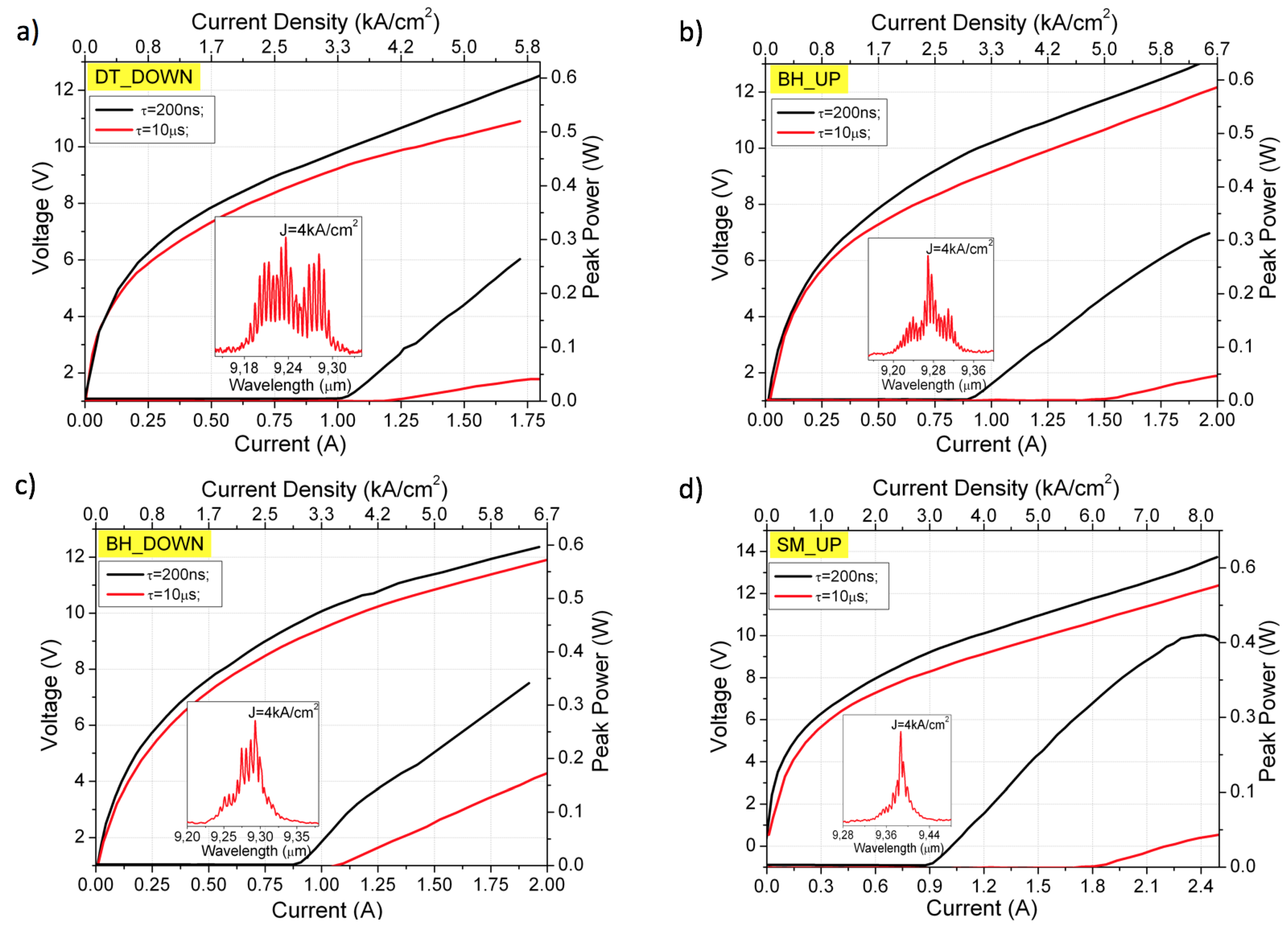
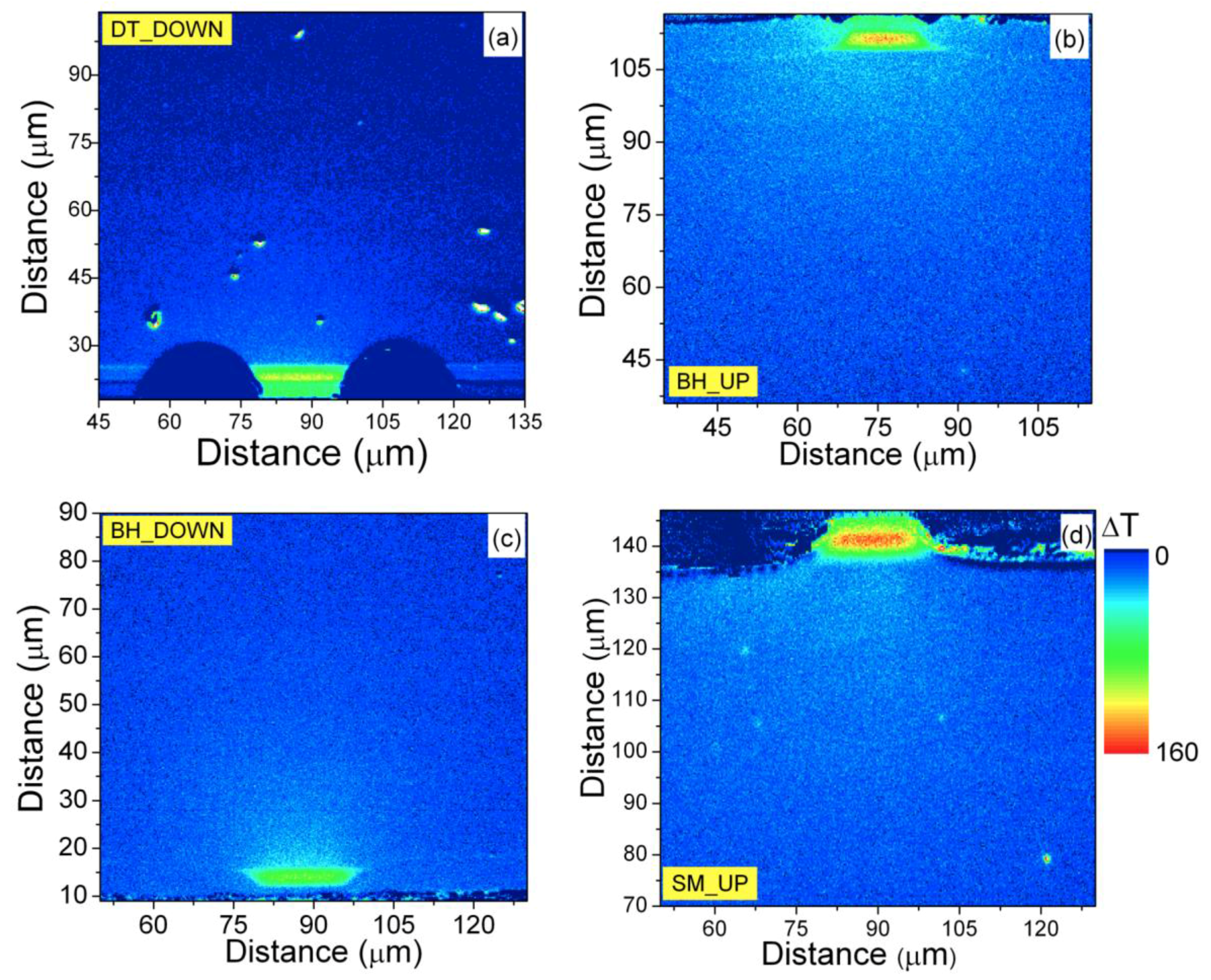

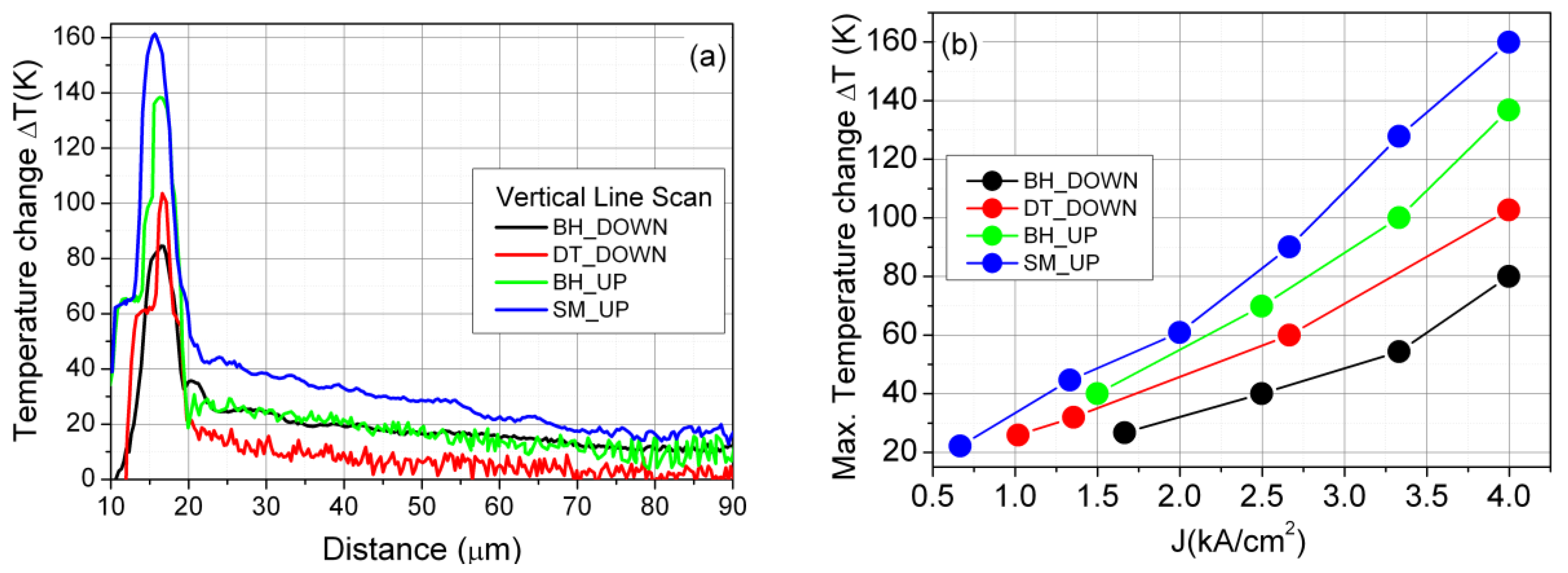
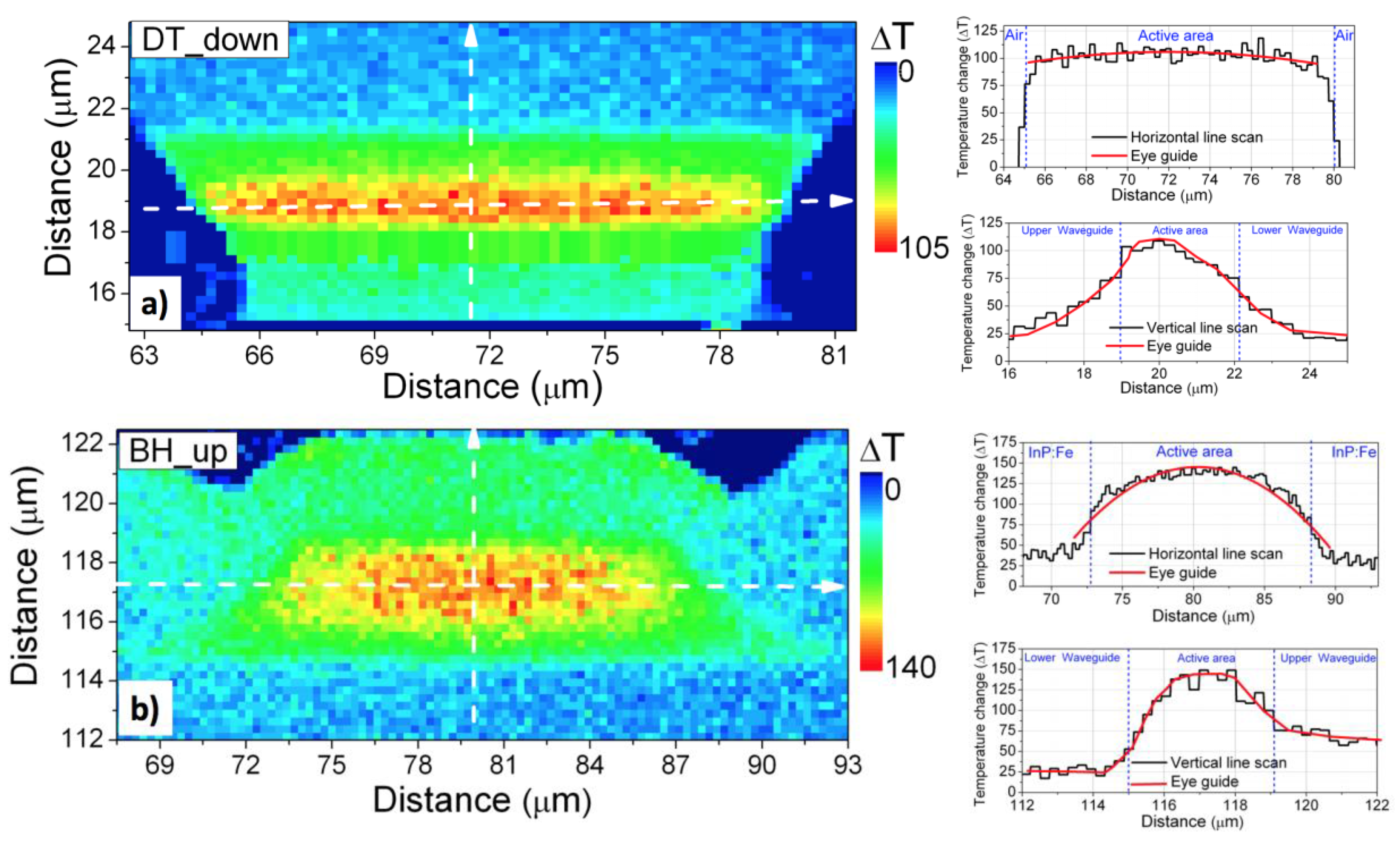
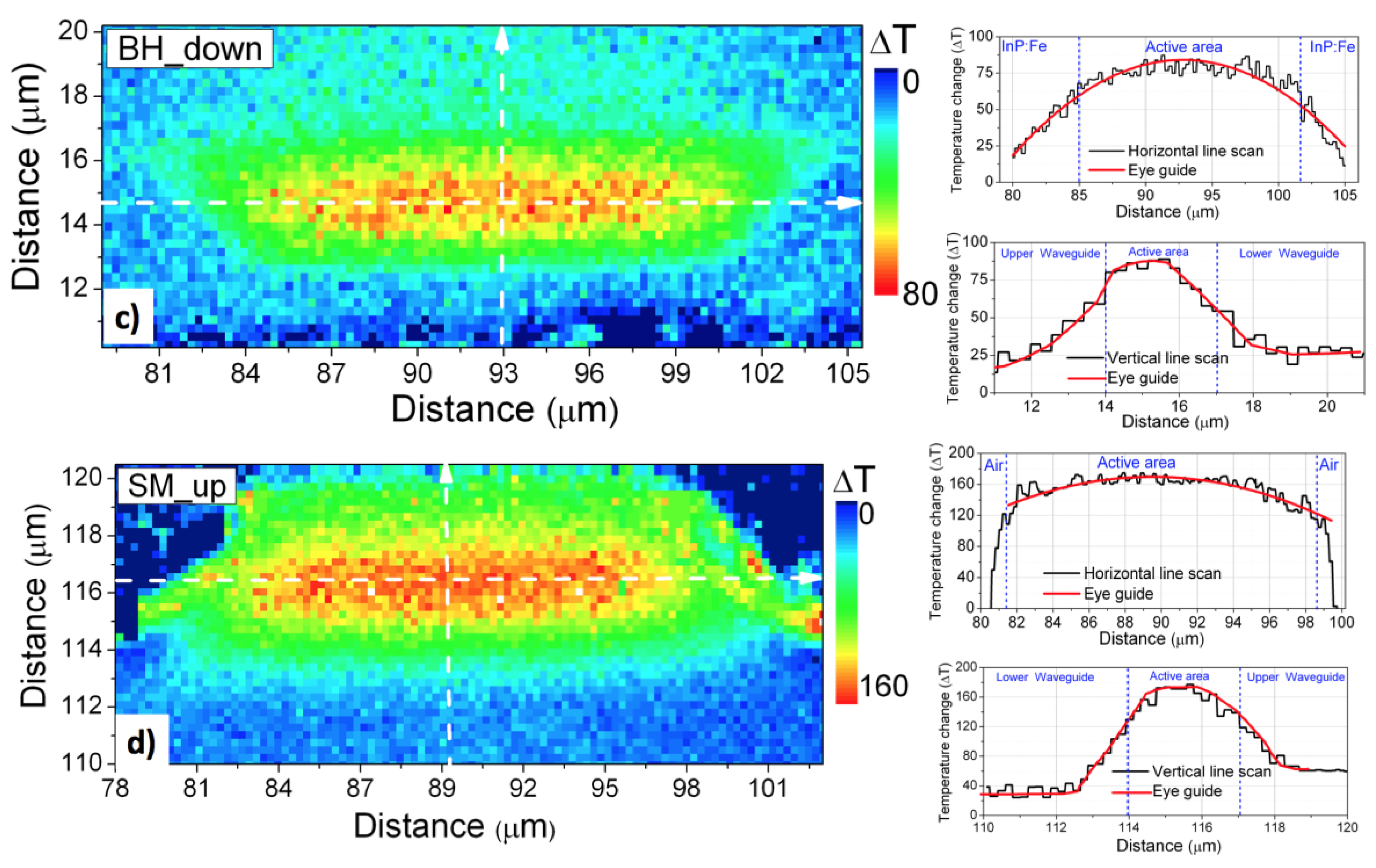
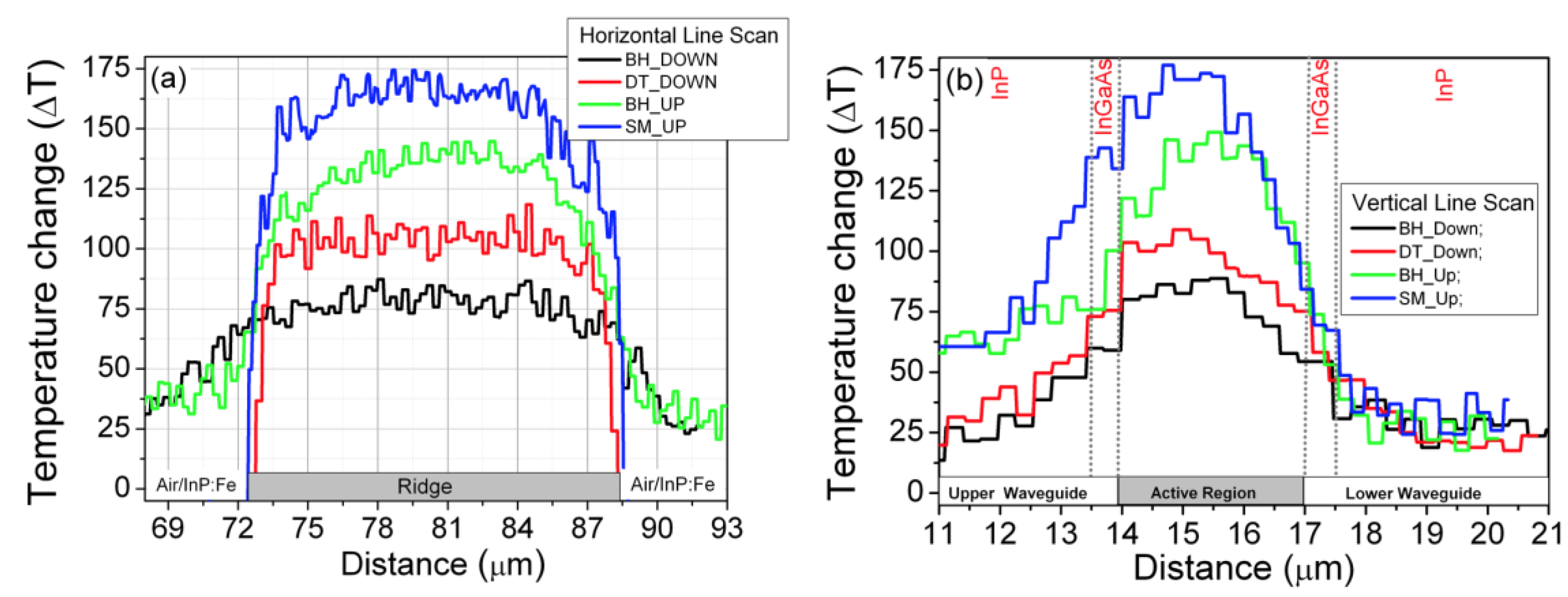
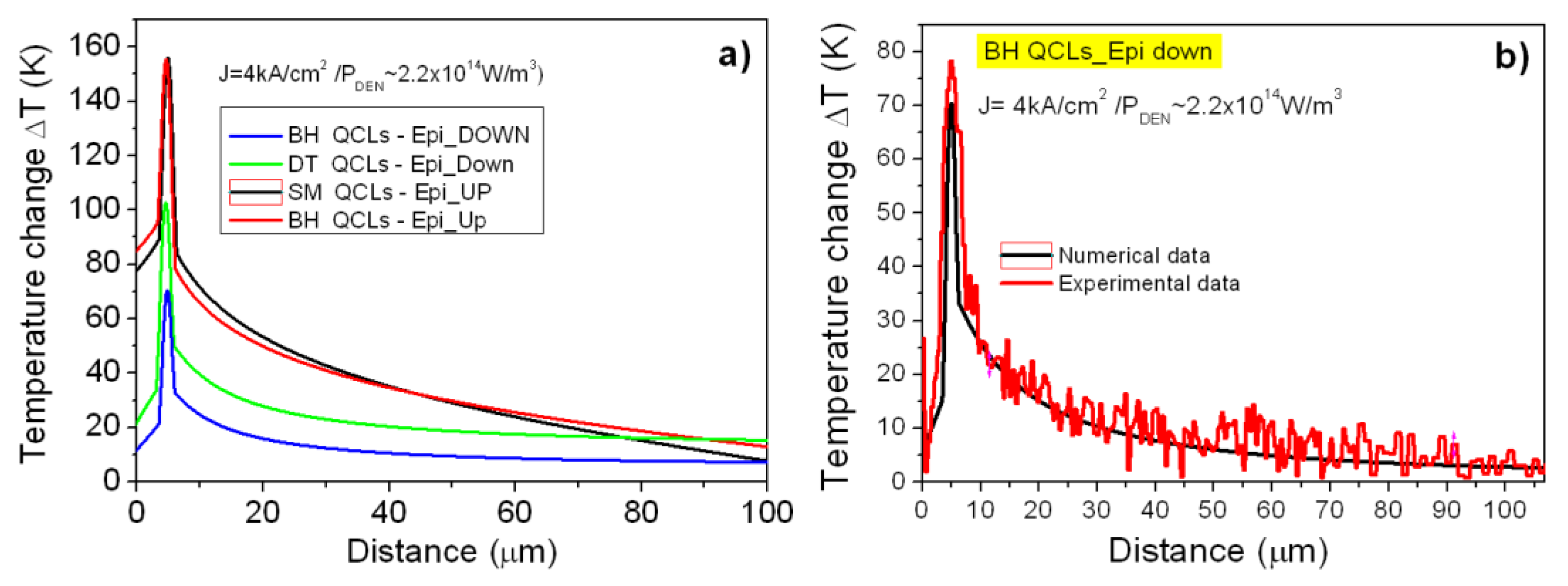
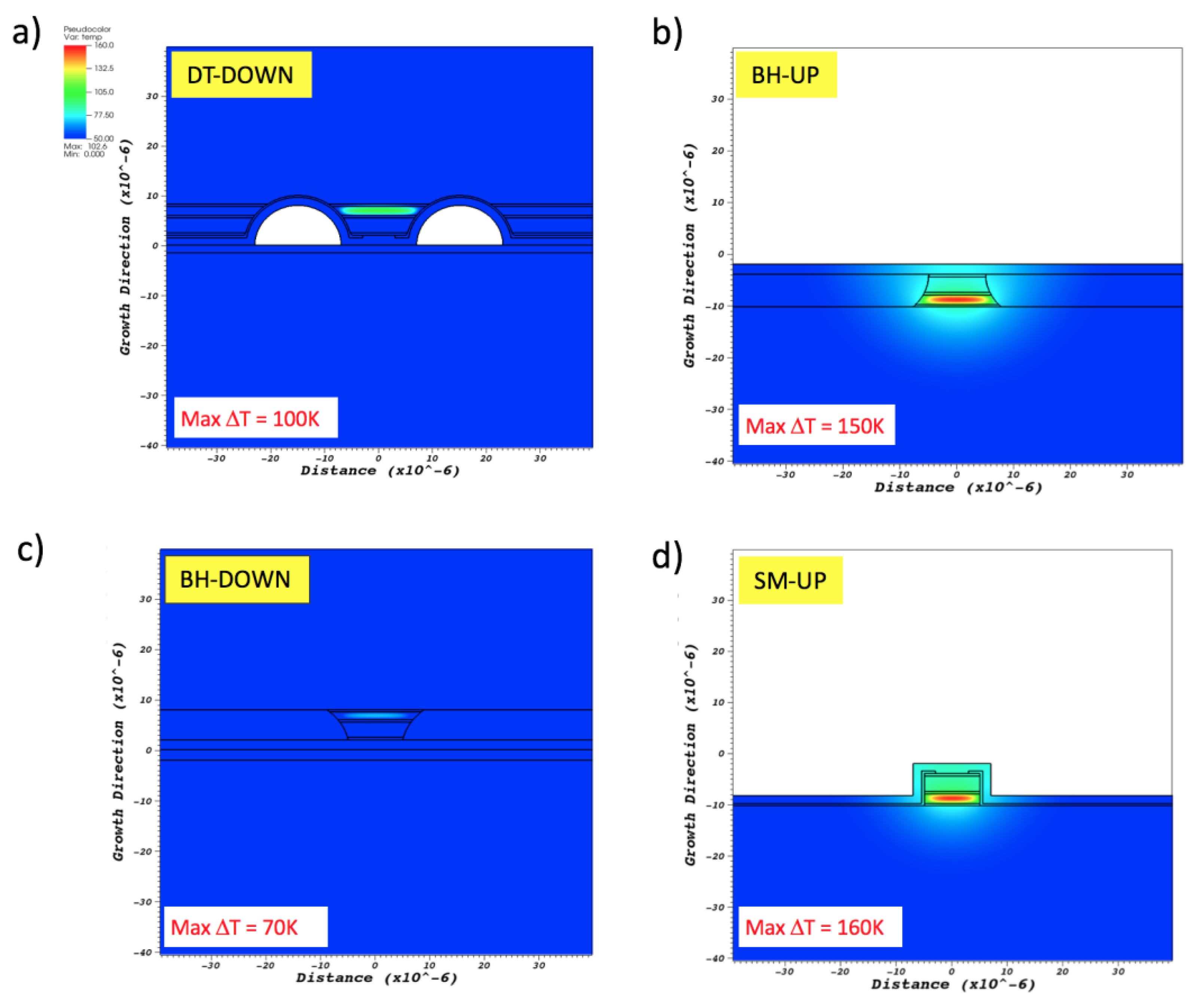
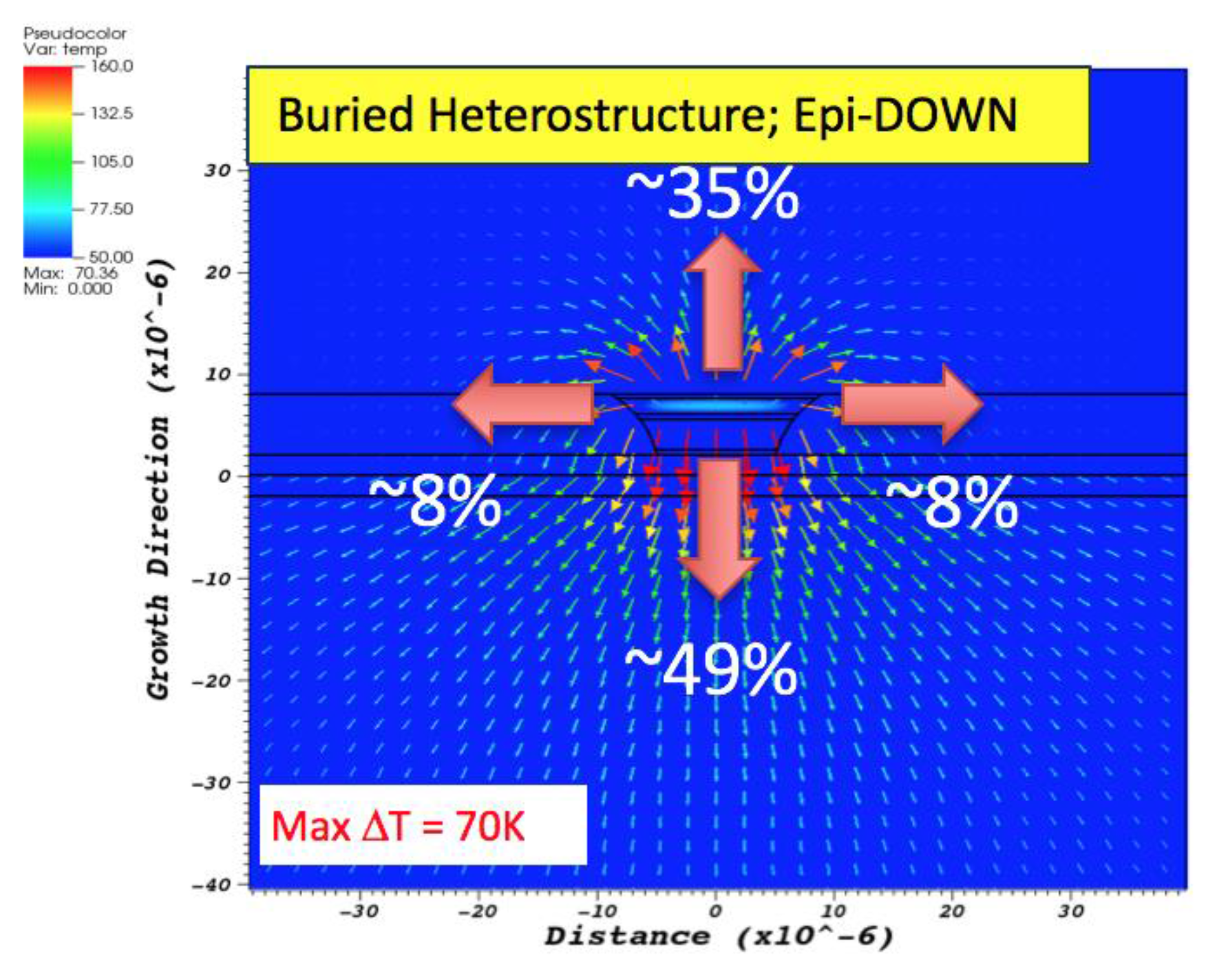
| Thickness | Material | Doping | |||
|---|---|---|---|---|---|
| Upper Waveguide (MOVPE) | 500 nm | InP | n = 8 × 1018 cm−3 | ||
| 1.5 µm | InP | n = 1 × 1017 cm−3 | |||
| 1.5 µm | InP | n = 4 × 1016 cm−3 | |||
| 500 nm | InGaAs | n = 4 × 1016 cm−3 | |||
| Active Region | 50 × AlInAs/InGaAs | ||||
| 500 nm | InGaAs | n = 4 × 1016 cm−3 | |||
| Lower Waveguide (MOVPE) | 1.5 µm | InP | n = 4 × 1016 cm−3 | ||
| 1.5 µm | InP | n = 1 × 1017 cm−3 | |||
| 500 µm substrate | InP | n = 2 × 1017 cm−3 | |||
| QCL STRUCTURE | Max ∆T(K) Experiment | Max ∆T(K) Simulation |
|---|---|---|
| DT_DOWN | 105 K | 100 K |
| BH_DOWN | 80 K | 70 K |
| BH_UP | 140 K | 150 K |
| SM_UP | 160 K | 160 K |
© 2017 by the authors. Licensee MDPI, Basel, Switzerland. This article is an open access article distributed under the terms and conditions of the Creative Commons Attribution (CC BY) license (http://creativecommons.org/licenses/by/4.0/).
Share and Cite
Pierścińska, D.; Pierściński, K.; Gutowski, P.; Badura, M.; Sobczak, G.; Serebrennikova, O.; Ściana, B.; Tłaczała, M.; Sobczak, G.; Bugajski, M. Heat Dissipation Schemes in AlInAs/InGaAs/InP Quantum Cascade Lasers Monitored by CCD Thermoreflectance. Photonics 2017, 4, 47. https://doi.org/10.3390/photonics4040047
Pierścińska D, Pierściński K, Gutowski P, Badura M, Sobczak G, Serebrennikova O, Ściana B, Tłaczała M, Sobczak G, Bugajski M. Heat Dissipation Schemes in AlInAs/InGaAs/InP Quantum Cascade Lasers Monitored by CCD Thermoreflectance. Photonics. 2017; 4(4):47. https://doi.org/10.3390/photonics4040047
Chicago/Turabian StylePierścińska, Dorota, Kamil Pierściński, Piotr Gutowski, Mikołaj Badura, Grzegorz Sobczak, Olga Serebrennikova, Beata Ściana, Marek Tłaczała, Grzegorz Sobczak, and Maciej Bugajski. 2017. "Heat Dissipation Schemes in AlInAs/InGaAs/InP Quantum Cascade Lasers Monitored by CCD Thermoreflectance" Photonics 4, no. 4: 47. https://doi.org/10.3390/photonics4040047





